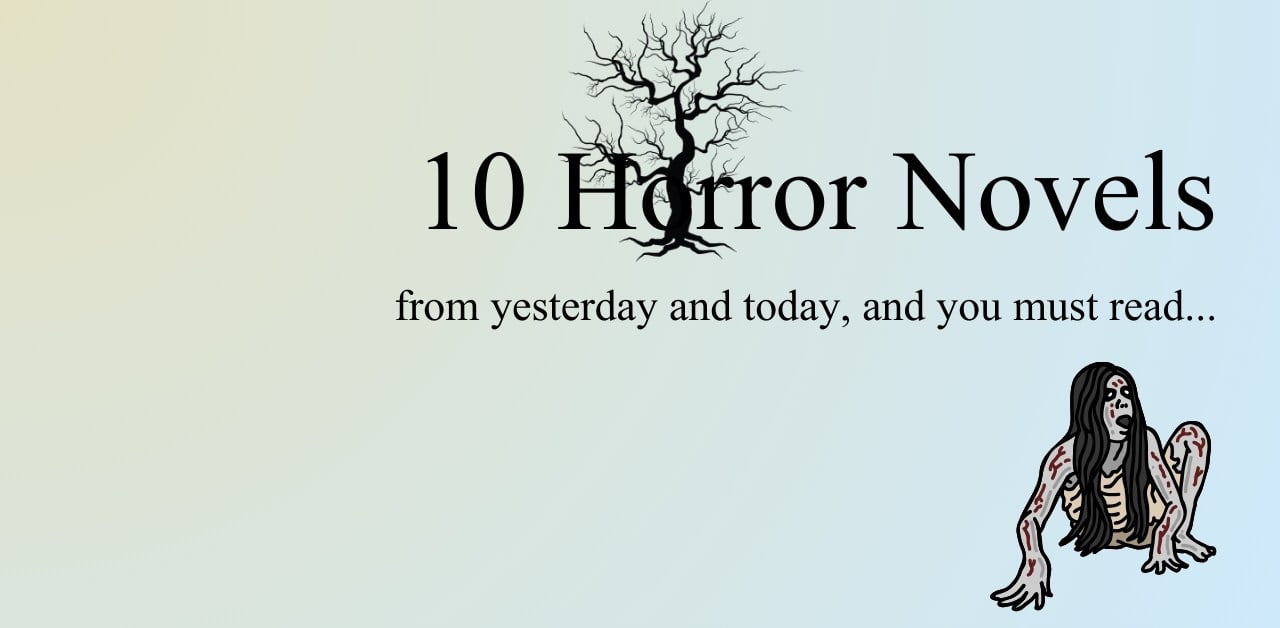Readers, here are the ten best horror novels in English you must read!
The allure of horror novels lies in their ability to elicit spine-tingling thrills, plunge readers into the depths of the unknown, and explore the darkest recesses of the human psyche. As we embark on a journey through the annals of horror literature, we encounter a myriad of tales that have captivated readers for centuries. From the Gothic horrors of Mary Shelley’s “Frankenstein” to the psychological suspense of Thomas Harris’s “The Silence of the Lambs,” each novel delves into the macabre with its own unique blend of terror and intrigue. In this exploration, we unravel the essence of these timeless works, delving into the chilling narratives that have left an indelible mark on the genre.

And here is the list of 10 horror novels you must read:
1. “Frankenstein” by Mary Shelley (1818):
Mary Shelley’s “Frankenstein” epitomizes classic horror, recounting the story of Victor Frankenstein, a young scientist who, driven by ambition, creates a grotesque creature through a forbidden scientific experiment. The novel traces the creature’s descent into desperation and vengeance, offering a chilling exploration of the consequences of tampering with the boundaries of life and death.
2. “Dracula” by Bram Stoker (1897):
Bram Stoker’s “Dracula” unfolds the iconic tale of Count Dracula, a vampire who relocates from Transylvania to England in pursuit of fresh blood. Interwoven with themes of good versus evil and the perils of the unknown, the narrative follows a group of friends as they strive to thwart Dracula’s reign of terror, creating a timeless exploration of fear and the supernatural.
3. “The Haunting of Hill House” by Shirley Jackson (1959):
Shirley Jackson’s “The Haunting of Hill House” ensnares readers in a sinister mansion where a group investigates supernatural phenomena. As they delve deeper, the group confronts their own fears and the malevolent secrets embedded within Hill House, presenting a haunting portrayal of psychological horror and the enigmatic nature of the paranormal.
4. “The Shining” by Stephen King (1977):
Stephen King’s “The Shining” unfolds a tale of a family that becomes caretakers at an isolated and haunted hotel during winter. As supernatural forces grip the family, especially the father, Jack Torrance, the narrative escalates into a terrifying descent into madness and violence, epitomizing the psychological horror genre.
5. “The Exorcist” by William Peter Blatty (1971):
William Peter Blatty’s “The Exorcist” delivers a horrifying account of a young girl possessed by a demonic entity. The novel explores the nature of evil and the struggle between good and evil as two priests endeavor to exorcise the demon, presenting a chilling narrative that probes the depths of spiritual terror.
6. “The Silence of the Lambs” by Thomas Harris (1988):
Thomas Harris’s “The Silence of the Lambs” is a gripping psychological horror novel following FBI trainee Clarice Starling as she interviews the notorious serial killer, Hannibal Lecter. In her pursuit of another killer, Clarice confronts the darkness within herself and the psychopathic minds she seeks to understand, creating a suspenseful and thought-provoking narrative.
7. “The Woman in Black” by Susan Hill (1983):
Susan Hill’s “The Woman in Black” weaves a chilling ghost story around young lawyer Arthur Kipps, who encounters a spectral woman foretelling the death of a child in a remote village. The novel masterfully combines atmospheric horror with a sense of impending doom, offering a timeless exploration of the supernatural.
8. “The Amityville Horror” by Jay Anson (1977):
Based on true events, Jay Anson’s “The Amityville Horror” recounts the harrowing experiences of the Lutz family, who discover their new home in Amityville is haunted by malevolent spirits. The novel details their struggle for survival as they confront terrifying events, delivering a spine-chilling narrative rooted in real-life horror.
9. “The Turn of the Screw” by Henry James (1898):
Henry James’s classic horror novella, “The Turn of the Screw,” follows a young governess caring for two orphaned children at a remote estate. As she perceives the spirits of the estate’s former inhabitants, paranoia sets in, creating a haunting tale that blurs the lines between supernatural and psychological horror.
10. “The Haunting of Alaizabel Cray” by Chris Wooding (2001):
Chris Wooding’s “The Haunting of Alaizabel Cray” unfolds a chilling narrative in Victorian London, where young woman Alaizabel Cray is possessed by a malevolent spirit. Thaniel Fox, attempting to help her, discovers a world of magic and evil, setting the stage for a dark and dangerous exploration of the supernatural.
Conclusion:
As we traverse the corridors of these horror novels, each pulsating with its own distinct brand of fear, we come to appreciate the diverse tapestry of terror woven by these literary maestros. From the Gothic horrors of Shelley and Stoker to the psychological depths plumbed by King and Harris, these novels stand as timeless testaments to the enduring allure of horror literature. Whether one seeks the visceral thrill of the supernatural or the nuanced exploration of the human psyche, these novels offer a gateway to the darkest realms of imagination, ensuring that the legacy of horror in literature endures through the ages.
Parmarth for Desi Readers
